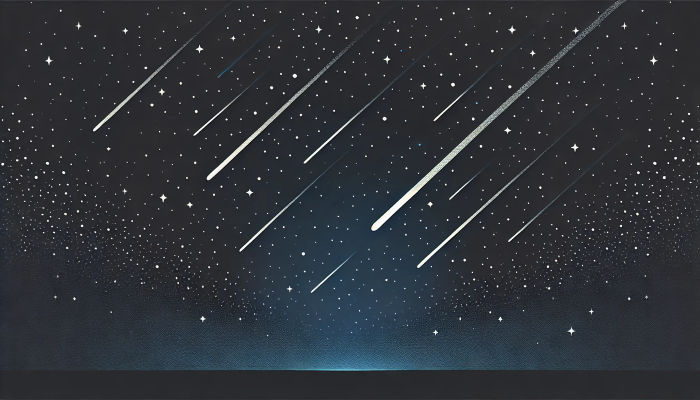| 2025: Calendar of Meteor Showers (2025-1-02) ⬅︎ |
 |
Have you ever caught a glimpse of shooting stars? Those fleeting streaks of light in the night sky that vanish just as quickly as they appear? Maybe you’ve seen ones that leave behind smoky trails, like trains, or the super bright ones that sometimes break apart or explode like fireworks.
Stargazers worldwide are captivated by shooting stars, but what are they really? Although they might seem like super fast versions of the stars we see in the sky, a better name is meteors. These tiny pieces of rock and metal are leftovers from the formation of our solar system. When they hit our atmosphere at lightning speed, they burn up and create a glow around them. Isn’t that cool?
Stargazers often feel lucky and excited when they spot a meteor, but guess what? They’re actually pretty common. Earth is constantly being bombarded by millions of these particles every day, and a few might even be seen every hour, especially in dark and clear skies.
What really gets stargazers’ hearts racing are the special times when the number of meteors seems to skyrocket from a few per hour to dozens or even hundreds. These events are called meteor showers, and there are over a hundred of them recognized that happen every year. We’ve listed some of the major ones below.
Surprisingly, meteor showers have to do with comets and asteroids. These small, cold, and distant objects sometimes have orbits that bring them closer to our solar system. The intense heat and radiation from the Sun can cause them to release huge amounts of debris (called meteoroids) into space, forming a cloud as this photo taken by the Rosetta spacecraft shows.
Meteor showers happen when Earth, in its orbit around the Sun, crosses paths with this debris. For many showers, we know the parent comet or asteroid responsible.
Meteor showers happen around the same time each year, so we can mark our calendars. Each shower has a range of dates and a peak time when the most meteors will appear. For instance, the Perseid Meteor Shower runs from July 17 to August 24, and the best time to see them is around August 13. But the exact date can vary because of leap years and where you are on Earth.
We also know where to look in the sky. The radiant is the point from which the meteors seem to come. The name of a shower comes from the constellation with the radiant. The Perseids are the major shower with the radiant in Perseus.
Now, here’s the thing: we can’t predict exactly how many meteors we’ll see. A shower gets a number called the zenithal hourly rate (ZHR), which is like an estimate of what you’d see during the peak hour if everything was perfect - no light pollution, no clouds, no moon, and the radiant was super high overhead. But the actual number you see will usually be lower, and it can vary a lot from year to year.
So, when’s the best time to watch a meteor shower? Most people like to watch them in the evening, but that’s not the best time. The best time starts after midnight and gets better each hour until just before dawn. This is because of where you are on Earth as it orbits the Sun and collides with the debris.
Here’s a fun way to think about it: imagine you’re in a moving car during a snowstorm. You start by looking at the falling snow through the back window, then through the side window, and finally, through the front windshield. As your view rotates from back to front, the snow will seem to be hitting your car faster and harder.
Do you wonder why we say faster is better? Well, it’s all about the energy! When a meteor hits the air in Earth’s atmosphere, it releases a burst of energy. This energy makes the meteors brighter, and we get to see more of them. And guess what? The fastest meteors are the Leonids. They zip across our sky at an incredible speed of 44 miles per second, which is like 160,000 miles per hour! Can you imagine that?
Now, I know some of you might be thinking, “But aren’t meteors called shooting stars?” Well, technically, they’re not. But let’s call them shooting stars anyway! After all, they’re made up of tiny pieces of rock and metal that formed inside stars a long time ago. But when the stars exploded as supernovas, these pieces were shot into space. So, go ahead and call them shooting stars!
Calendar of Major Meteor Showers
| Shower | Dates | Rate (ZHR) | Speed (mi/s) | Radiant | Parent | 2024 Peak |
| Quadrantids | Dec 26 - Jan 16 | 120 | 30 | Bootes | Comet 2003 EH1 |
Jan 2/3 |
| Lyrids | Apr 15 - 29 | 18 | 30 | Lyra | Comet Thatcher |
Apr 21/22 |
| Eta Aquariids | May 19 - 28 | 55 | 41 | Aquarius | Comet Halley |
May 5/6 |
| Delta Aquariids | Jul 12 - Aug 23 | 20 | 25 | Aquarius | Comet 96P/Machholz | Jul 30/31 |
| Perseids | Jul 17 - Aug 24 | 100 | 37 | Perseus | Comet Swift/Tuttle | Aug 11/12 |
| Orionids | Oct 2 - Nov 7 | 20 | 41 | Orion | Comet Halley | Oct 20/21 |
| Leonids | Nov 6-20 | 10 | 44 | Leo | Comet Tempel/Tuttle | Nov 16/17 |
| Geminids | Dec 4-20 | 120 | 22 | Gemini | Asteroid 3200 Phaethon | Dec 13/14 |
|
| |



